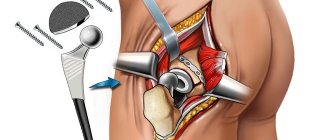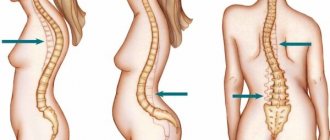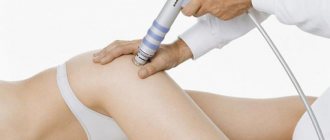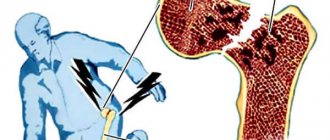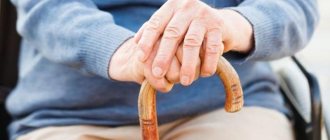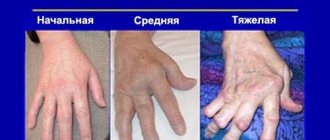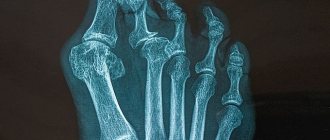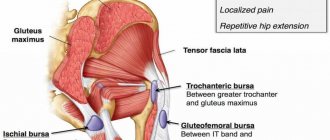Arthrosis is a serious progressive disease that can ruin many plans for the future. It is not surprising that he was included in the list of those in which, at a certain stage, the status of “person with disabilities” is assigned. Under what conditions does this happen and is it possible to avoid such a fate?
A medical and social examination will decide whether you will be assigned a disability group.
Classification of pathology
Degrees according to Kosinskaya:
- First: minor changes. There is no pronounced limitation of movements. Slight narrowing of the joint space. Pathological growths are only at the stage of formation.
- Second: movement in the joint is limited. It only comes in a certain direction. A crunching sound appears with any movement and can be heard from a distance. An x-ray shows a narrowing of the diarthrosis gap by 2 or 3 times. Osteophytes become large and epiphyseal cysts form. Moderate muscle atrophy is noted.
- Third: lack of intra-articular fluid. Diarthrosis is severely deformed and compacted. The joint space becomes closed with the development of ankylosis. Many spurs form throughout the joint. An x-ray image reveals cartilaginous fragments with bone cysts.
Questions about registering a disability group
A diagnosis of joint coxarthrosis does not mean that with such a disease a person is automatically given disability status. To receive pension contributions and social benefits, a person must undergo an official procedure for recognizing a person’s disability status in the form of receiving the appropriate group.
The possibility of assigning a certain disability group and determining which group is assigned is determined on the basis of symptoms of pathological changes in the hip joint and restrictions in a person’s life (LR). A group confirming disability is given only in the presence of 2 or 3 degrees of joint destruction in the presence of pronounced impairments in the functional ability of the hip bones to move.
About the signs and symptoms of arthrosis >>
The possibility of assigning a certain disability group is determined by a medical commission. A medical examination is carried out for the following indications:
- arthrosis is characterized by rapid progress;
- the patient underwent surgery for indications of arthrosis;
- The patient experiences a clear restriction of joint movement, which is an obstacle to full life activity.
The severity of clinical symptoms must be observed for at least 3 years. The disease must occur with symptoms of exacerbation with a frequency of at least 3 times during the year. The referral to the commission is given by the attending physician, who may be an arthrologist or orthopedist.
Modern medicine shows good effectiveness, even if disability was previously diagnosed due to grade 3 coxarthrosis of the hip joint. In this regard, the issuance of a group does not mean obtaining status for the rest of your life.
Endoprosthetics today make it possible to almost completely restore the normal functioning of the joint, which leads to the removal of the disability group. In addition, according to Russian law, a disabled person must undergo a medical examination every year to confirm his disability.
When can disability be assigned?
If a patient is diagnosed with arthrosis in stages III and IV, cure is impossible. The attending physician must refer him for a medical and social examination, which will assign him a disability.
The second and third groups are workers. With the first, a person is limited in movement. Therefore, the group is considered non-working.
With grade III gonarthrosis, the symptoms are identical to arthrosis of the hip joint. The deforming lesion may affect other joints. However, coxarthrosis is the most severe by its nature.
This is important to know: Disability with gonarthrosis
If, during the examination, a noticeable limitation in the mobility of diarthrosis is revealed in the patient and he is not capable of self-care, the commission assigns him the third group. The second is due to persons who have lost the opportunity to serve and support themselves.
If the patient undergoes endoprosthesis replacement of the affected joint, function may be restored and the condition of diarthrosis may improve. In these cases, the disability group is often lowered or even removed.
Attention! Severe pain in a damaged joint is not grounds for issuing disability. The presence of stiffness and arthralgia are only a diagnostic symptom. A group is assigned when signs of disability are identified.
Conditions for referral to MSE for arthrosis
Of course, it is not possible in all cases to obtain the appropriate status if you have the disease in question. The doctor determines the need to undergo an examination if an applicant for the group:
— has been suffering from arthrosis of the joints for three years since the onset of the disease, and the condition is prone to progression (at least three exacerbations occur per year);
— after surgery recommended for osteoarthritis, when there are disorders that negatively affect life;
— encountered significant violations of static-dynamic function.
If we consider the degrees of motor functionality, doctors will highlight three main ones:
- slight discomfort that occurs during certain movements (for example, flexion-extension of the knee, etc.);
- severe pain, a noticeable crunch, present even during normal activity, as well as a decline in the motor ability of the joint against the background of an increase in the muscle joints overlying the joint;
- changes in the structure of the joint, which can be designated as critical and, in addition, limited mobility with muscle swelling.
The concept of “limitation of life activity”
The definition of acute deformity includes deformities of joints and bones. They must be confirmed by x-ray and arthroscopic examination methods.
OZD includes:
- Self-care limitation 1st degree: the patient cannot perform the entire volume of physical activity. He has to crush them and use orthopedic devices (stick, cane). More time is spent on self-care.
- Ability to move 1st degree: it is partial, the patient has to use auxiliary orthopedic devices - crutches, a cane.
- Orientation ability of the 1st degree: a person orients himself only in a familiar situation or thanks to auxiliary technical means.
- Ability to communicate 1st degree: the patient partially assimilates information. Technical means are used;
- Behavior control 1st degree: when difficult situations arise, is the patient able to control himself. Partial self-correction is observed.
- Ability to learn 1st degree: the patient’s previous qualifications are reduced, the amount of work done is reduced, but he is still able to work.
Features of assignment of disability for coxarthrosis of the 3rd degree
According to doctors, a therapeutic effect for grade 3 coxarthrosis and complete restoration of motor function is possible only through prosthetics. The last stages of the disease can make a person unable to move independently. To prevent irreversible changes, therapy is carried out using the following methods:
- drug treatment;
- therapeutic gymnastics;
- massage treatments;
- diet;
- physiotherapy.
In case of unfavorable development of events, grade 3 coxarthrosis of the hip joint is assigned to 2 or 1 disability groups. With such changes in the body, a person is often unable to perform work and in most cases cannot move. The patient may be immobilized and restoration of the functions of the hip joint in such circumstances is only possible through surgical intervention in which the joint is replaced with an endoprosthesis.
The first disability group is considered the most severe and is diagnosed when a person is unable to move and perform basic everyday activities. In most cases, such patients cannot live independently and need support from others.
Three stages of the disease
Depending on the severity of the pathological process, the disease affects the patient’s life in different ways. Arthrosis includes 3 stages:
- First: the symptoms are hardly noticeable due to external changes in the body. The disease manifests itself as minor pain during physical activity. At this stage, pathological disturbances in the composition of the intra-articular fluid have already occurred.
- Second: the destruction of diarthrosis occurs. Growths form on the bone tissue. The pain becomes more intense, but still tolerable. During movements, a crunching sound occurs. Muscle function is affected.
- Third: articular cartilage has become much thinner. Areas of destruction form on the bone tissue. The patient complains of limited mobility. Subluxations of the joints develop, and the axis of the limb changes.
Stages of development of the disease and their connection with disability
All arthrosis is a group of pathologies in which degenerative and deformational changes occur in tissues. Coxarthrosis is a fairly common pathology; in most cases it is diagnosed in women.
The mechanism of development of pathology is as follows:
- The joint fluid thickens, causing the cartilage surface to dry out and become cracked.
- Cracks provoke thinning of cartilage, which leads to pathological processes in tissues.
- The bones are deformed, the mobility of the hip area is impaired, local metabolism deteriorates, and the muscles of the affected leg atrophy.
The development of coxarthrosis occurs in several stages:
- The initial stage is difficult to notice even on x-rays, so the disease very quickly progresses to the next stage. But a person who is attentive to his health must pay attention to pain in the groin area and discomfort when walking. Disability at this stage is absolutely excluded.
- The second stage the clinical picture is more obvious. Pain can appear not only during activity, but also at rest. The patient has difficulty lifting the affected limb, and discomfort in the knee area makes it difficult to bend it. If motor functions are lost to a significant extent at this stage of the disease, disability can be assigned, but this does not happen often.
- The third stage of pain is very severe, as necrotic changes occur in the joint. As a rule, in this case, the patient is recommended to undergo surgery. At this stage of the disease, the patient is assigned a disability.
- The fourth stage is the final stage in which the joint completely dies, causing severe pain and lameness when walking. In most cases, the patient requires a wheelchair and group 1 disability.
Read also: State disability pension for contract military personnel
How is the disability examination carried out?
When a medical and social examination is carried out, members of the commission assess the patient’s status according to the following criteria:
- X-ray examination according to Kosinskaya;
- additional diagnostic methods;
- the degree of violations of the SDF;
- rate of progression of deforming osteoarthritis.
Degree of impairment of statodynamic function (SDF)
Doctors distinguish 4 degrees of SDF impairment:
- Minor violations. The patient walks 3-5 km at a pace of 90 steps/min. Aching pain appears. An x-ray shows stage I of deforming osteoarthritis.
- Moderate violations. Characterized by joint contracture with limitation of movements. The patient can only walk 2 km: he is bothered by lameness and pain in the joint. You have to rest for the pain to subside.
The leg shortens up to 4 cm and muscle strength decreases by 40%. The X-ray image shows stages I-II of DOA.
Subsequently, joint pain and lameness become constant. The patient is able to walk only 1 km using a cane. His pace is 45-50 steps/min. The patient has severe contracture, leg shortening up to 6 cm. When measuring the volume of the hips on both limbs, a difference in readings of 4-5 cm is revealed, and on the legs - by 1-2 cm. Muscle strength is 70% less. An x-ray shows stage II of deforming osteoarthritis.
- Pronounced violations. The patient experiences pain in the lumbar region and both joints. The leg is shortened by 7 cm or more. The patient is able to walk only half a kilometer using crutches. His pace is 25 steps/min.
Muscle atrophy is observed. The volume in the hips on both limbs differs by 6 cm or more, and the shin by 3 cm or more. Muscle strength decreases by over 70%.
X-rays reveal grades II and III of deforming osteoarthritis. Decompensation of motor function and radicular syndromes are observed.
- Significant changes. The patient is unable to make any movement. He lies down all the time or moves only within the room using a walker.
First stage of examination
To obtain a group, a person suffering from DOA must prove that the treatment provided was unsuccessful. He needs to collect confirmation.
The attending physician needs to issue a referral for medical examination based on the papers prepared by the patient and diagnostic results:
- UAC;
- OAM;
- ECG;
- fluorography of OGK;
- X-ray examination of the affected joint in two projections;
- conclusions of narrow specialists (orthopedist, neurologist, surgeon).
The doctor must collect the listed papers, after which he issues a referral to the ITU. Members of the commission study the documents and the effectiveness of the completed therapeutic course. They must carefully assess the condition of the sick person and the severity of the signs of the disease.
Second and third stages of examination
At stage 2, the patient’s social adaptability and psycho-emotional state are determined. The commission assesses the ability to provide vital needs, move independently and perform certain work. The ITU Bureau should take into account the possibility of remediation measures.
At stage 3, the data obtained during the medical and social examination is analyzed. Experts determine how much the patient needs outside help. After that, they assign one of the disability groups.
What to do if you are not given a disability?
There are often cases when grade 2 coxarthrosis does not result in disability. Based on my experience, confirming disability is a difficult task. Of all the patients I referred to MSEC (I’m talking in general, and not about coxarthrosis separately), only about 60% receive disability. The commission refuses the rest, despite the fact that I and the patients themselves considered the grounds for disability sufficient.
So in the case of coxarthrosis - a majority vote of MSEC members can decide that the limitations in the functionality of the hip joint are not significant, and the patient can remain able to work with minor restrictions (hard physical labor is not recommended). However, if you do not agree with the decision of the MSEC, you can challenge it in higher authorities (regional, main bureau of the MSEC) or through the court.
Group assignment criteria
To give a person a disability due to arthrosis, members of the commission use special criteria. Based on them, they assign one group or another.
First disability group
Main criteria:
- motor function is completely lost or incompatible with work and self-care;
- the inability of a person to perform any physical actions without the help of people.
The first group is assigned to the following patients:
- with stages III and IV of arthrosis of the lower extremities;
- ankylosis of the 3rd degree - disability is also included;
- coxarthrosis or gonarthrosis stage III.
Second disability group
Main criteria:
- the patient has partially lost motor function: he is able to move without assistance or special devices;
- the limb is shortened by 7 cm or more;
- the disease became progressive.
The second disability group is assigned to persons with the following diseases:
- Stage III arthrosis of the lower extremities;
- ankylosis of large joints;
- severe osteoporosis (II or III degree);
- coxarthrosis or gonarthrosis stages II and III.
Attention! When a patient undergoes endoprosthetics, and then his condition improves, the BMSE has the right to cancel the disability completely.
Third disability group
Main criteria:
- the patient has a slight limitation in motor function: the speed of performing actions is significantly lower compared to a healthy person;
- the patient has slightly lost the ability to self-care at home;
- performance is reduced or he cannot perform certain work.
The third group is assigned to the following diseases:
- stage II osteoporosis;
- gonarthrosis or coxarthrosis stage II.
For what violations is disability assigned?
Disability may be prescribed for the second, third or fourth stages of arthrosis. The question of whether rheumatoid arthritis in adults gives disability can be answered positively. However, the final decision is made by ITU specialists.
In the later stages of rheumatoid arthritis or arthrosis, a person can hardly move independently and experiences severe pain that does not stop even in a calm state. There are numerous restrictions on life activity, up to the inability to care for oneself. Since joint mobility is almost completely absent, a person is forced to move either with the help of crutches or in a wheelchair.
This condition cannot be reversed or cured, so doctors usually recommend applying for disability. This is also possible with a combination of several of the following symptoms:
- progressive disease with constant relapses;
- rapid development of pathology with a significant deterioration of the patient’s condition;
- surgery caused by arthrosis;
- loss of ability to work;
- a combination of several diseases (for example, arthritis and arthrosis).
If there is only one complaint, disability will not be assigned. But if a patient suffers from several symptoms of arthrosis that significantly reduce his quality of life, he may be assigned a group.
Rheumatoid arthritis is a disability because it is an autoimmune disease that destroys the cartilage structures of the joints. The consequences of rheumatoid arthritis are insidious and can affect not only the joints, but also the internal organs. Therefore, the patient must receive appropriate treatment.
Amount of pension and monthly allowance for disability
Patients who have become disabled have the right to cash subsidies from the state. The size of the payment depends on the group.
Table: “Disability pension in 2021.”
| Name | Group | Payment (rub./month) |
| Social pension | Disabled since childhood, I group, disabled children | 11 445,68 |
| I group and disabled people from childhood, II group. | 9 538,2 | |
| II gr. | 4 769,09 | |
| III gr. | 4 053,74 | |
| EDV | I | 3 137,6 |
| II | 2 240,7 | |
| III | 1 793,7 | |
| Disabled children | 2 240,74 |
Functional diagnostics
In order to identify gonarthrosis of the affected joint and begin to treat it correctly, methods are used that are conventionally divided into laboratory and instrumental.
Arthroscopy examines the joint using an LED conductor, which is inserted into the cavity opening on the side of the knee. This method allows you to see the internal structure of the affected area. The advantage of this method is its versatility (it is used not only for diagnostic, but also for therapeutic purposes). The disadvantage of this method of detecting violations is the possibility of microorganisms entering the depressurized joint cavity.
To read: Treatment of spinal compression fractures in children
Using arthroscopy, you can remove chondrophytes, synovial polyps, and correct the shape of the menisci.
Computed tomography helps the specialist to recreate images of the diseased area along its entire circumference. After processing on a computer, specialists receive a three-dimensional image. Often used to examine the hip joint. The increased radiation dose is fully compensated by detailed data.
X-rays are performed in two projections to obtain images from all sides. To reliably display pathological processes, a multilateral x-ray of a healthy knee is often performed. After this, a comparison is made.
Ultrasound examination to detect grade 2 arthrosis of the hip joint or knees began to be used relatively recently. This method is completely safe for the patient’s health, so it can be used not just once, but several times. Ultrasound allows you to examine the soft tissues of the joint in more detail.
Magnetic resonance imaging detects photons of a specific wavelength that are emitted by hydrogen particles as they return to their starting point when exposed to a magnetic field. This method is harmless to humans. With its help you can clearly see soft tissues.
Thermography is based on the study of body temperature fields. Where there are malignant or inflammatory foci, the temperature is much higher. Therefore, detecting grade 3 gonarthrosis of the knee joint, for example, will not be particularly difficult.
During scintigraphy, a special substance is introduced into the body of the patient under study, which reacts to a specific type of tissue, so grade 2 or other gonarthrosis is determined immediately. During an exacerbation of pathology of the ankle joint or any other joint, laboratory diagnostics are also used (general analysis of urine, blood, biochemical blood test), because with its help it is also possible to identify the course of the inflammatory-intoxication process.
Degrees of gonarthrosis
Based on clinical manifestations, the following degrees of pathology are distinguished:
- First stage. The appearance of mild pain after physical activity on the joints, which goes away on its own without medications. Short-term swelling in the joints may occur, but the shape of the joint does not change.
- Second stage. The pain in the knees becomes more frequent and intensifies, and a crunching sensation occurs when moving. In the morning, the patient may complain of some difficulty in movement, which disappears after physical warm-up. The shape of the knees begins to change, their size increases.
- Third stage. Pain is observed almost constantly, walking becomes difficult, and lameness appears. Deformation and increase in the volume of the joint are clearly pronounced.
- Fourth stage. Clinical signs correspond to stage 3 of the disease, and it is possible to determine that the disease is progressing only by x-rays. It is noticeable on them that the joint space is completely absent.
Classification of deforming osteoarthritis according to Kosinskaya
The clinical and radiological classification according to Kosinska has been used since 1961 and is as follows:
- First stage. The joint is slightly limited in movement. X-rays show small growths of bone along the edges of the articular cavity, there are foci of ossification of the cartilage and a decrease in the joint space.
- Second stage. The mobility of the joint is limited in certain directions, and a rough crunching sound is heard. The x-ray shows significant growth of bone tissue, and the joint space is reduced by 2 times. There are signs of subchondral sclerosis.
- Third stage. The joint is deformed to a significant extent, movements are sharply limited, only rocking movements can be preserved. On X-ray, the joint space is not visible, the epiphyses are deformed and compacted, and as a result of strong bone growths, the articular surfaces are expanded.
Functional diagnostics, assessment of SDF
When a patient performs functional tests, the specialist measures the range of motion of the joint, and 4 degrees are distinguished:
- less than 50% of the norm;
- 25-40%;
- 15%;
- the joint is completely immobilized, the limb is shortened, fixed in a functionally awkward position.
To assess the SDF, the specialist relies on X-ray data and functional tests, and also pays attention to the following:
- duration and severity of pain;
- the pace of movement of the patient, the duration of the distance without a rest break, the ability to move without assistance and without devices;
- change in leg size.
The following degrees of expression are distinguished:
- Minor. The range of motion is reduced by less than 10%, compensation is normal, pain is observed only after exercise and goes away after rest.
- Moderate. The contracture is moderate. Lameness appears. After rest, the symptoms go away. The limb becomes smaller by 4 cm or more, muscle strength decreases sharply, and the thigh circumference on the affected leg decreases by 2 cm.
- Moderate, in a late stage. The contracture is clearly expressed, compensation is insufficient, pain is constantly present, the pathology progresses, the limb decreases in length by 5 cm, and the circumference of the lower leg decreases by 2 cm.
- Expressed. The contracture is severe, the decompensated stage, lameness, the circumference of the lower leg decreases by 3 cm, the thigh - by 7 cm, the limb becomes shorter by 7 cm. Muscle strength is practically absent,
- Significantly expressed. The patient's movements are limited - he can move with difficulty, and only with the help of strangers or devices.
